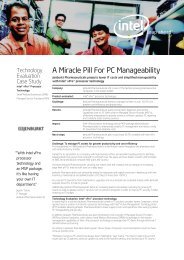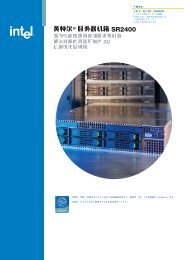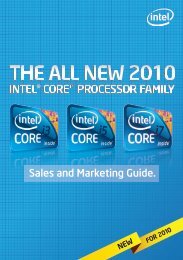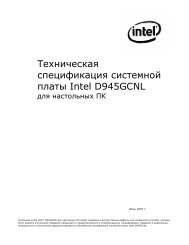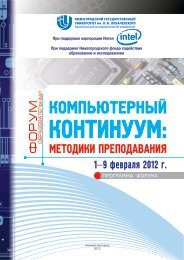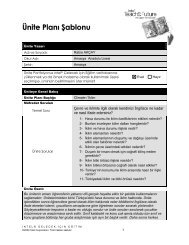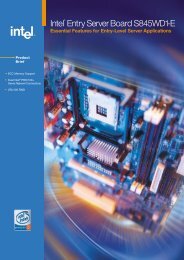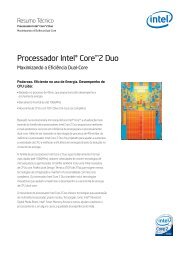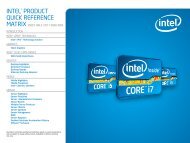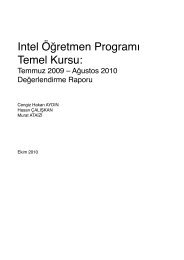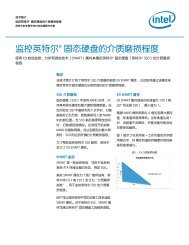Technical Product Specification for Canoe Pass - Preminary - Intel
Technical Product Specification for Canoe Pass - Preminary - Intel
Technical Product Specification for Canoe Pass - Preminary - Intel
Create successful ePaper yourself
Turn your PDF publications into a flip-book with our unique Google optimized e-Paper software.
<strong>Intel</strong>® Server Board S2600CP Functional Architecture <strong>Intel</strong> ® Server Board S2600CP and Server System P4000CP TPS<br />
as Hot-Plug. AHCI requires appropriate software support (<strong>for</strong> example, an AHCI driver) and <strong>for</strong><br />
some features, hardware support in the SATA device or additional plat<strong>for</strong>m hardware.<br />
4.3.6 Rapid Storage Technology<br />
The Patsburg chipset provides support <strong>for</strong> <strong>Intel</strong> ® Rapid Storage Technology, providing both<br />
AHCI and integrated RAID functionality. The RAID capability provides high-per<strong>for</strong>mance RAID 0,<br />
1, 5, and 10 functionality on up to 6 SATA ports of the Patsburg chipset. Matrix RAID support is<br />
provided to allow multiple RAID levels to be combined on a single set of hard drives, such as<br />
RAID 0 and RAID 1 on two disks. Other RAID features include hot-spare support, SMART<br />
alerting, and RAID 0 auto replace.<br />
4.3.7 PCI Interface<br />
The Patsburg chipset PCI interface provides a 33 MHz, Revision 2.3 implementation. The<br />
Patsburg chipset integrates a PCI arbiter that supports up to four external PCI bus masters in<br />
addition to the internal Patsburg chipset requests. This allows <strong>for</strong> combinations of up to four PCI<br />
down devices and PCI slots.<br />
4.3.8 Low Pin Count (LPC) Interface<br />
The Patsburg chipset implements an LPC Interface as described in the LPC 1.1 <strong>Specification</strong>.<br />
The Low Pin Count (LPC) bridge function of the Patsburg resides in PCI Device 31: Function 0.<br />
In addition to the LPC bridge interface function, D31:F0 contains other functional units including<br />
DMA, interrupt controllers, timers, power management, system management, GPIO, and RTC.<br />
4.3.9 Serial Peripheral Interface (SPI)<br />
The Patsburg chipset implements an SPI Interface as an alternative interface <strong>for</strong> the BIOS flash<br />
device. The SPI flash is required to support Gigabit Ethernet and <strong>Intel</strong> ® Active Management<br />
Technology. The Patsburg chipset supports up to two SPI flash devices with speeds up to 50<br />
MHz.<br />
4.3.10 Compatibility Modules (DMA Controller, Timer/Counters, Interrupt Controller)<br />
The DMA controller incorporates the logic of two 82C37 DMA controllers, with seven<br />
independently programmable channels. The Patsburg chipset supports LPC DMA through the<br />
Patsburg chipset’s DMA controller.<br />
The timer/counter block contains three counters that are equivalent in function to those found in<br />
one 82C54 programmable interval timer. These three counters are combined to provide the<br />
system timer function, and speaker tone.<br />
The Patsburg chipset provides an ISA-Compatible Programmable Interrupt Controller (PIC) that<br />
incorporates the functionality of two 82C59 interrupt controllers. In addition, the Patsburg<br />
chipset supports a serial interrupt scheme.<br />
All of the registers in these modules can be read and restored. This is required to save and<br />
restore system state after power has been removed and restored to the plat<strong>for</strong>m.<br />
40<br />
<strong>Intel</strong> Confidential Revision 0.8<br />
<strong>Intel</strong> order number G26942-003



